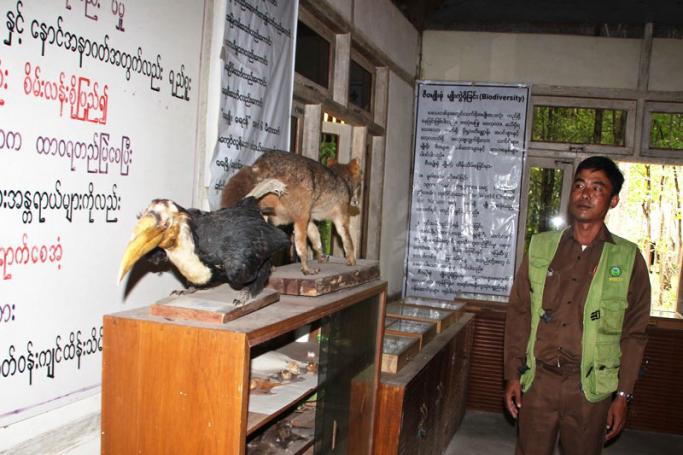In the heart of Myanmar’s central dry zone there are two protected forest areas that are home to word’s largest populations of endangered Eld’s deer.
Chatthin in Sagaing Region and Shwesettaw in Magwe Region are two long-established wildlife sanctuaries with a rare type of dry forests where the species - called rucervuseldii or ‘Golden Deer’ in Burmese - lives. But during a recent visit to Chatthin I learned that the forest and its species are under threat from poaching and encroachment, while authorities struggle to stave off the sanctuary’s decline.
“We used to patrol around when we heard gunshots and would arrest the hunters. However, they are now using traps made of steel wires. So we cannot hear any sound when the deer hunting is going on and cannot make arrests,” Win ZawLun, a forestry officer at Chattin Sanctuary, told me.
“Locals trap and kill the deer for a small amount of money. They do not have the knowledge to understand that killing these rare animals is a great loss,” he said. Win ZawLun explained that the roughly $80 villagers can earn from capturing a Golden Deer represents a large sum compared to the few dollars per day they receive from doing farm work.
Chatthin was established in 1941 and covers roughly 103 square miles and parts of Kantbalu and Kawlin townships. The sanctuary employs 34 staff and is reached by a bumpy two-hour motorbike ride from Chatthin town.
A large picture of a pair of Eld’s Deer welcomes visitors at the gate and a small museum showcases some stuffed versions of the roughly 1,500 species of wildlife in the park, including monkeys, birds, various deer, wild pig, wild dog and a number of unique insects.
Its forests are dominated indaing (dipterocarpus) plants, as well as teak and other hardwood trees.
This makes for an ideal habitat for Eld’s deer, said Myint Myint Soe, a forestry officer at the sanctuary.
“Foreign experts said Chatthin Wildlife Sanctuary is a more suitable habitat for Golden Deer than its counterpart Shwesettaw in Magwe Region, although the latter has more deer,” she said. “The number of this endangered species is declining faster in Chatthin.”
According to official figures, the number of deer in the park fell an estimated 50 percent since 1995, when there were thought to be some 3,000 animals in Chatthin.
The decline mirrors a wider loss of forests and wildlife habitats across Myanmar that has gathered pace since the country’s political opening up began in 2011. A report published in March 2015 said that forest conversion for commercial agriculture is accelerating at an “unprecedented rate” in Myanmar, putting the country’s biodiversity at risk.
During my visit, I joined park officials and we searched for the shy deer, but all we could see was a few hoof marks and a brief rustling of bushes where they were believed to be hiding.
Three villages are located inside the sanctuary and some 20 villages straddle its edges. For many locals in this impoverished area the forest and its resources are an essential source of income that supplements their farm work.
Villagers are aware of its protected status but have traditionally collected firewood, bamboo shoots and other food and non-food forest products in Chatthin. Some will sneak in to poach its wildlife with home-made guns or traps.
Officials told me that during my visit a patrol had just found three women digging for the roots of wild palm trees and let them off with a warning. The edible roots are sought after in China and fetch about $1 per 2.5 kilo on the local market.
Authorities said they lack funding to carry out programmes to educate villagers on the importance of conservation, or to provide them with alternative sources of income. The laws for protecting the sanctuary do not stipulate clear penalties for those breaching its rules, so criminal laws are sometimes used against poachers, a measure that park officials say is too severe.
“We conduct educational programmes, asking them to surrender their handmade guns while pardoning them from holding these weapons. However, police insist on taking action against illegal possession of these weapons. Such procedures makes the locals reluctant to hand over their guns,” said Myint Myint Soe.
She said more emphasis should be put on fostering understanding of Chatthin's unique ecological value among locals, while further cooperation with authorities and alternative livelihood programmes should also be supported.
Myint Myint Soe said conservation programmes with such a focus would offer the best way of protecting Chattin’s natural heritage, but this would require more funding.
Having seen the Chattin sanctuary and the role it plays as important refuge for the Eld’s deer, I can only agree and hope that Myanmar’s government or international conservation organisations can protect it for future generations.
You are viewing the old site.
Please update your bookmark to https://eng.mizzima.com.
Mizzima Weekly Magazine Issue...
14 December 2023
Spring Revolution Daily News f...
13 December 2023
New UK Burma sanctions welcome...
13 December 2023
Spring Revolution Daily News f...
12 December 2023
Spring Revolution Daily News f...
11 December 2023
Spring Revolution Daily News f...
08 December 2023
Spring Revolution Daily News f...
07 December 2023
Diaspora journalists increasin...
07 December 2023
UNHCR chief appeals to Myanmar government to help IDPs, refugees












